The Fires of Canneto di Caronia
Prev |
1 |
2 |
3 |
4 |
5 |
Next
See working papers in Canneto Think Tank.
A Shade Tree Physics Online Publication
Page was started on 12 Feb 2004. Latest Update 21 Mar 2019. (Part 1)
New or modified text is in bold.
This document, or portions thereof, may be copied freely for non-profit/non-commercial purposes.
In February 2003 Mt. Etna was reported to be plugged up. A research team found "what they believe is (was) a massive body of solid magma intruding from about one mile to about 11 miles deep beneath the mountain, causing a pressurization of the mountain's deep plumbing system which had fractured the rock." Liquid magma was thought to be "moving through cracks and fissures and collecting in an area about 1.8 miles below the surface." (A copy of this report "Mount Etna Waiting To Erupt; 2003" used to be at http://www.platetectonics.com but is no longer available) Until recently I have been thinking that some of this magma may have been moving beneath the village of Canneto di Caronia. [Modified 21 August 2005 and on 14 Sep 2013.] [The first part of this paragraph is "borrowed" from the chronological notes for 5 March 2004, in part 3.]
The approaching magma may have been producing methane which is then being forced up through the ground, probably in several places. (This may not be noticed in sparsely populated areas.) Carbon disulfide has also been proposed. (The molten magma may also be producing electron clouds by thermionic emission. These should move easily through the ground.) Some of the methane (colorless - odorless), or other flammable gas, which reaches the surface in the Canneto area could have become trapped inside homes. (John Curtis, in a Science groupserv.com geology forum, also suggested (in April 2004) the possible presence of Methane. He thought that when warmer weather arrives, and houses were opened up more, the problems would subside. [Modified 25 April and 2 May 2004 and 14-15 Sep 2013.]
It may be that a Mt. Etna magma path was not the direct culprit, as described above, but the fact that Etna was plugged up may have indirectly affected Canneto via a larger network of volcanic interconnections, perhaps from as far away as Mt. Stromboli. [Added 14 Sep 2013.]
Here is a map showing the location of Canneto and the volcanoes in the area. The circle of volcanoes to the north of Sicily gives a hint of the aforementioned volcanic interconnections. (Bluish volcanoes are subsurface.) [Added 30 Dec 2013.]
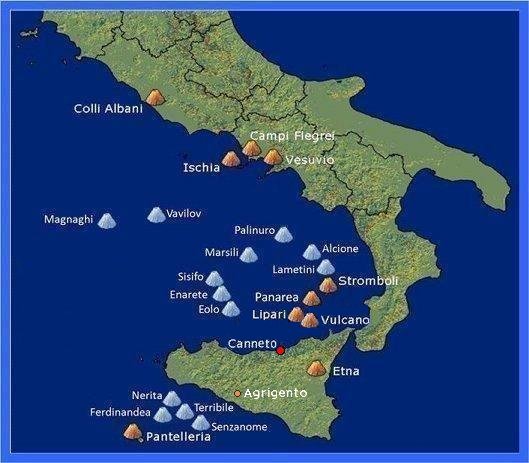
Canneto and Volcanoes in the Area of Italy
Map (before additions) Courtesy of Protezione Civile
The mud volcanoes at Agrigento, Sicily are shown as a brown dot. See Sicily's other volcanoes.
According to one source when the A20 tunnels, uphill from Canneto, were being constructed, volcanic gas was encountered which seems to have come from Mount Stromboli. (See the 04 April 2005 entry in Canneto Think Tank, Part 2.)
Here is a cross-section of the Canneto di Caronia area showing a hypothetical sub-surface magma path associated with an outlying magma plumbing branch originating from Mt. Stromboli. (Prior to 27 Sep 2013 I had been showing the magma plumbing as coming from Mt. Etna.)
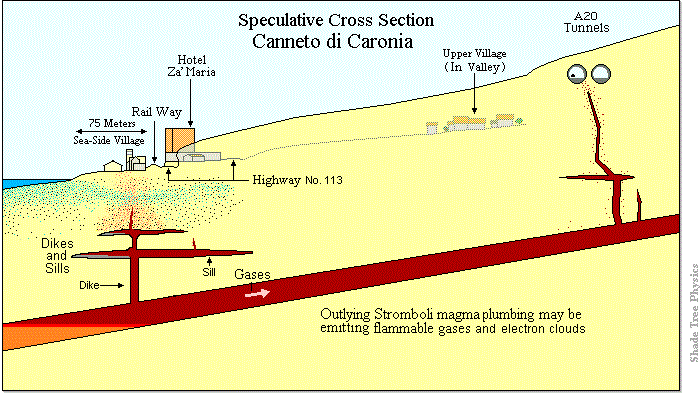
Speculative Geological Cross-Section in the area of Canneto di Caronia [Updated 03 Nov 2014.]
Here is a Google Earth bird's-eye-view image of Canneto di Caronia.
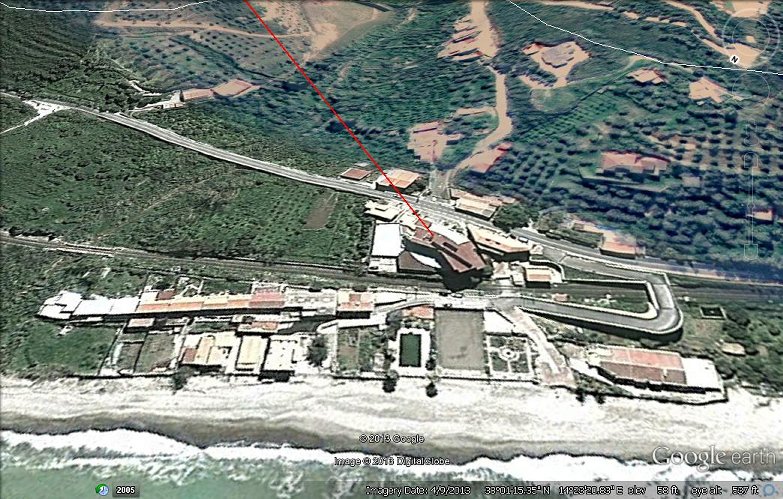
Google Earth bird's-eye-view of Canneto di Caronia looking to the the SSE
Red line connects to Mt. Etna
Electrical arcs associated with normal use of household appliances, or static electricity discharges which occur under conditions of low humidity, may be enhanced by the magma electron cloud, if it exists, [See: Canneto di Caronia (ME)] ignites the methane. The methane flashes should be, by themselves, very short lived affairs. A longer burning fuel instead of or in addition to the methane seems required. [Modified 25 April 2004.]
Volcanic ash, which is flammable, was last deposited on Canneto by Mt. Etna in about February 2003. Remnants of that ash have most likely collected in hard-to-get-to places (inside appliances and pieces of furniture which have openings to the air. Air conditioner condensers come to mind.)
Volcanic ash itself (when ground underfoot) may be a source of electrical sparks by the process of triboluminescence. Sparks generated in this manner, by tracked-in ash, could also ignite the methane. If there is, from time to time, a large static electrical charge buildup inside the village homes, some of the volcanic ash could become electrically suspended in the air and provide the initial flash, instead of methane. One report has it that the fires tend to take place when trains are approaching the village. Could the weight of a train compress the ground and thus force an extra dose of methane (or electrons) to the surface? [Modified 25 April 2004.]
The idea is that electrical discharges (usually associated with human presence) ignites the methane which then triggers other combustibles, including volcanic ash, into fiery displays.
If it turns out that no flammable gas, such as methane, is found in the Canneto homes, then this current version will have to be modified. (So far, I have seen no report dealing with the presence or non-presence of methane in the Canneto homes.)
If this scenario comes to be validated then the residents of Canneto should consider the possibility of a volcano appearing in their town.
18 April 2004 - Postscript
See the 16 April 2004 entry on the Canneto Think Tank, Part 2 page.
13 September 2004 Insert
On 7 September 2004 (53 days after the unusual July rain) a new fissure opened in the Valle del Bove on the eastern slope of Mt. Etna. On 13 September a much shorter fissure opened up parallel to the first one, a few hundred yards to the south. On the night of 13-14 September the 2950m Etna Trekking webcam recorded glowing hot spots to the north of the summit craters. (The hot spots are marked as 14 Sep on the map.)
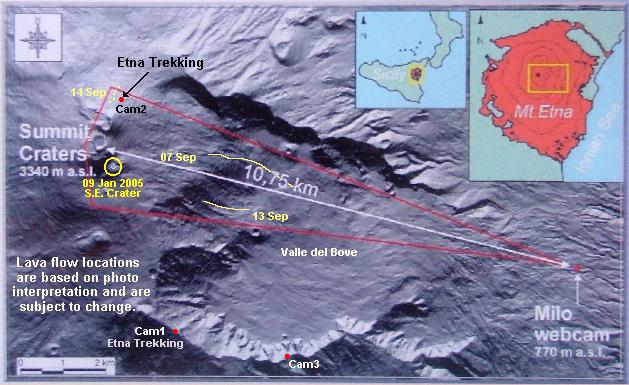
Map of Mt. Etna with Approx Locations (in yellow) New Fissure Actvity
This map was copied from the INGV* Sezione di Catania website. The map also shows the author's best guestimate of the locations of the Etna Trekking Webcams. *INGV = Istituto Nazionale di Geofisica e Vulcanologia
The next two graphics are also from INGV Sezione di Catania. They are Milo webcam views, looking west-northwest up through the Valle del Bove. They show the 7 September and 13 September fissures.
See INGV Milo view of the new fissures in Bove Valley
on 13 September 2004.
See INGV Milo view of the fissure activity in Bove
Valley on the night of 13 September 2004.
See Etna Trekking Cam2 overlapping views across Bove Valley.
Whether there is a connection between the unusual 15 July rainstorm and the new fissure activity is yet to be determined. (Ground-water which reaches the appropriate magma reservoirs, in sufficient quantity, can produce steam-driven bulging and fissure activity (or worse things). The bowl-like nature of the Valle del Bove might serve to concentrate rainwater in a crater-lake fashion before it descended toward Etna's plumbing system. Was there a short-lived lake in the bottom of the valley?
Visit the following Mt. Etna Webcam sites:
AlbaNet.com ,
Etna Trekking(*),
INGV,
etna2004 videobank.
[Three of these four links no longer work. 30 Mar 2010]
(*) The Etna Trekking website webcams are set up to install cookies on internet
visitor computers. You may need to relax your internet options privacy
level to see the images.
14 September 2004
Section on manually defusing Etna has been removed.
17 September 2004
During the night of 16-17 September, new hot spots of sluggish lava appeared on the
northeast slope of the central peak area of Mt. Etna. The 2950m Etna Trekking
webcam did a good job of recording this activity. The camera jiggled (producing
doubled images) several times during the night and into the morning. The cause of
these jiggles may have been gusts of wind, or perhaps volcanic tremors. That
camera was relatively close (estimated 0.5 to 1.0 mile) from the new surface lava
activity. [Revised on 21 September.]
18 September 2004
See the Etna Trekking 2637m webcam photographs for 17
September 2004. The 2637m camera is located south-southeast of Etna's summit.
The pictures document the 7 and 13 September flows along the floor of Bove valley.
The sunrise photos are downright fun. [Revised 21 September.]
The Active Volcanoes / Aktive vulkaner: Etna, Italy site has up-to-date news (with photos and lava flow maps) for the current Etna activity.
See Etna Volcano Photos - [Added 30 Oct 2004.]
12 October 2004
Assuming that there was a connection between Etna's having been
plugged up, and the seemingly spontaneous fires that occurred in
Canneto di Caronia, then as long as the lava flows in Etna's Valle del
Bove (or other places near the summit) continue to vent volcanic internal
pressures, the Village of Canneto di Caronia should have no further
problems with fires breaking out.
17 October 2004 (Revised 18 August 2005.)
See the following cloud activity animations which are based on still
frames made by Albanet's WebCam (2) on Oct. 16, 2004.
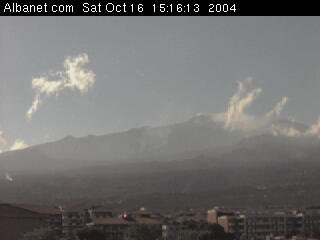
14:45:13 . . . . . . . . . . . . . . . . . . . . . . . . . . . | . . . . . . . . . . . . . . . . 15:28:13
One Minute Intervals (43 frames)
15:07:13.......................|.......................15:22:43
Half Minute Intervals (20 frames)
15:12:13...........|..........15:18:43
Half Minute Intervals (14 frames)
Of special interest is what seems to be a low-elevation water-cloud eruption that begins at 15:15:43 next to the left edge of the webcam field of view. The activity seems to have been occurring near a point identified as Ballo on Albanet.com's webcam map. [Link no longer works. 30 Mar 2010.] The activity location is marked by an inserted white arrow just before and during the start of the erruption. [Modified 18 August 2005.]
Also note the nearly complete disappearance of the billowy/wispy clouds, which were "playing" around on the upper southern and eastern slopes of Etna, which occurs at about the same time that the visible low-elevation (ground-level) water-vapor activity begins. [Modifed 18 August 2005.]
The following simplified schematic diagram of hypothetical Etna plumbing shows how some water vapor path blockage could produce the above described effects. [Added 18 August 2005.]
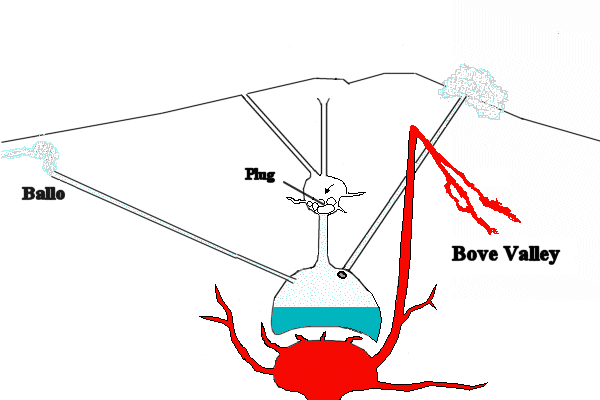
Schematic Diagram - Simplified Etna Plumbing
This page started on 12 February 2004 as an addition to the author's page on The Kite-Acheson Effect, but was pulled out of that page to become a stand-alone item on 8 March 2004. (It became apparent that solar storm induced electrical charge buildup may not have been the main culprit behind the fires at Canneto di Caronia, and instead that volcanic activity appears to provide a reasonable working hypothesis.)
Think Tank - The Fires of Canneto di Caronia
The think tank was installed on 9 April 2004 and contains excerpts from e-mails from other researchers and parties interested in the Fires of Canneto di Caronia. Entries are presented in chronological order.
2014 Canneto Fires
[Added 3 Nov 2014.]
Canneto di Caronia - "L'approfondimento" sugli ultimi incendi OndaTV Sicilia [Italian - 14:38 minutes]